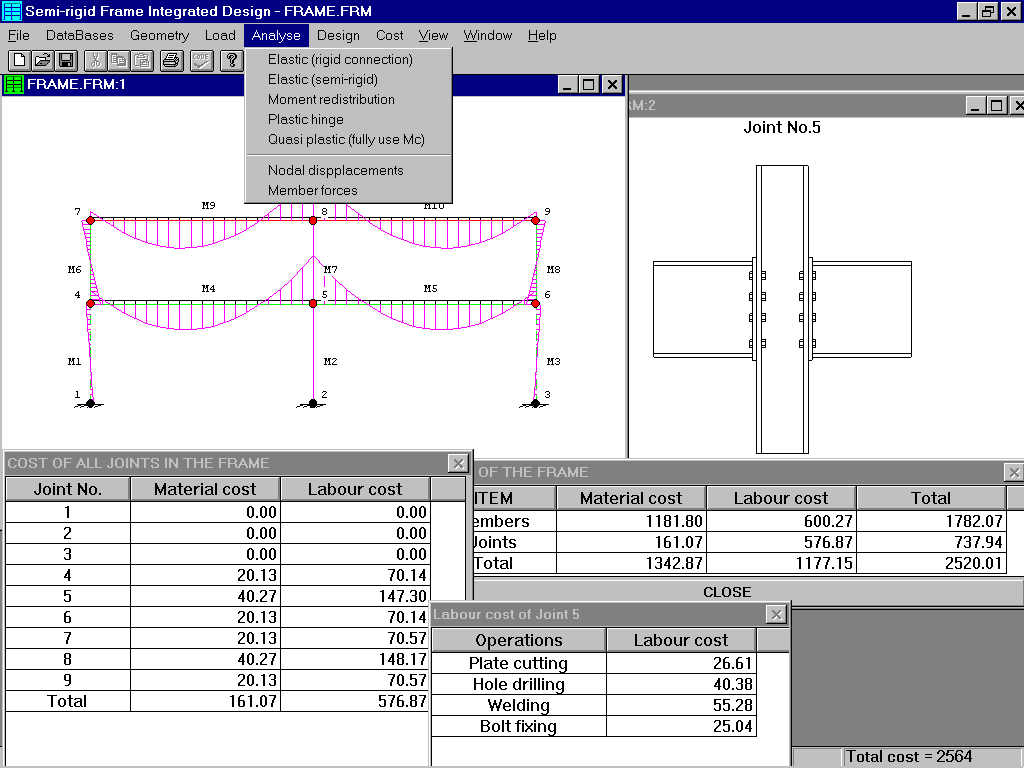
Integration of analysis, design and joint detailing for steel structures
A CIMsteel Project: Design for Manufacture
Researchers:
D A Nethercot
Department of Civil Engineering, University of Nottingham. UK
W M K Tizani
Department of Civil Engineering, University of Nottingham. UK
T Q Li
Department of Civil Engineering, University of Nottingham. UK
ABSTRACT: A prototype integrated software system has been developed to guide designers towards cost-effective solutions for steel building frames. The system is implemented through a series of modules covering: overall frame analysis, member and connection design and costing. Alternative designs - including those utilising the semi-rigid and partial strength properties of the connections - may be compared for both structural efficiency and relative costs. The costing covers both material and fabrication components and permits the designer to compare member, connection and overall frame costs at all stages of the process. In addition, guidance towards identifying courses of action to improve connection capacity and efficiency is provided through a set of knowledge based modules that serve as prompts to design decisions.

A screen-shot showing a two-storey building with the bending moment diagram imposed and the detailing of joint number 5. The spreadsheet dialogs show various cost items of the structure. The cost is indicative and not absolute and is used to compare the cost of this frame with an alternative scheme. The cost can be broken down to its basic elements such as material cost of each member, fabrication cost of each joint or the cost of individual fabrication operations (e.g. welding of endplate in Joint 5).
Background
Competitive structural design relies on producing cost-effective solutions in terms of the overall construction cost. This overall cost depends on several interacting factors: constructability of designs, lead-time of construction, minimising wastage of material, and amount of rework. Producing such designs in the current organisational structure of the industry is hampered because of its fragmentation, and the distributed and focused nature of responsibilities and expertise among the different organisations commonly involved in the same project.
In structural steelwork construction in the UK, the design process is executed independently and often with little awareness of its consequences on the fabrication and erection process. It is unlikely that designers would have had extensive experience in the fabrication of structures in addition to expertise in erection and even if this were true it is unlikely that they would also have access to practical cost-appraisal information at the formative stage of the project. It is often the case that designers concentrate on producing a structurally adequate frame, with less attention being paid to the connections and their details. The likely consequence of this being higher fabrication and erection costs, since construction costs depend substantially on the connections and the connection-related costs and not simply on material content.
Since design decisions made at the conceptual stage have the greatest influence on the overall cost of construction - due to their imposing constraints on all the stages that follow - designers have the prime responsibility for providing cost-effective solutions. It is important to re-engineer the processes involved in steel construction to permit creativity, analysis, assessment and feed-back of all down-stream activities, moving away from the traditional fragmented procedure to a more integrated one whereby designers have a greater appreciation of the other processes. This will facilitate the making of better-informed decisions at the conceptual stage, which is essential if truly competitive designs with implications for profitability and better value for money for clients are to be produced.
The conduct of a construction-led approach, where the designer would consider the consequences of design decisions on the activities that follows, is therefore advocated. However, for such an approach to be executed, designers must have at their disposal expertise in and in-depth knowledge about the construction stages of fabrication, transportation and erection. Both the "Design for Manufacture" and the "Design for Construction" guides disseminating from the CIMsteel project contain significant sections on selection and detailing of connections so as to facilitate cost-effective fabrication and erection.
Research work carried out at Nottingham University as part of the CIMsteel project has concentrated on providing designers with a tool that facilitate the design for Manufacture and construction approaches through the development of a demonstration system aimed at facilitating such approaches using information technology. The software system integrates all tools necessary for designers to carry out such designs. In the remainder of this document the essence of the system is described.
Re-engineering the design process using Information technology
A prototype integrated design system that can be used to improve the information flow between the various stages of construction and to 're-engineer' the process so that designs that put emphasis on constructability and cost as well as structural adequacy can be more easily produced. This is done by the effective integration of the downstream activities within IT tools used for the conceptual design. There are four main aspects to the system:
Written by Walid Tizani, last updated on 2 June 1997.